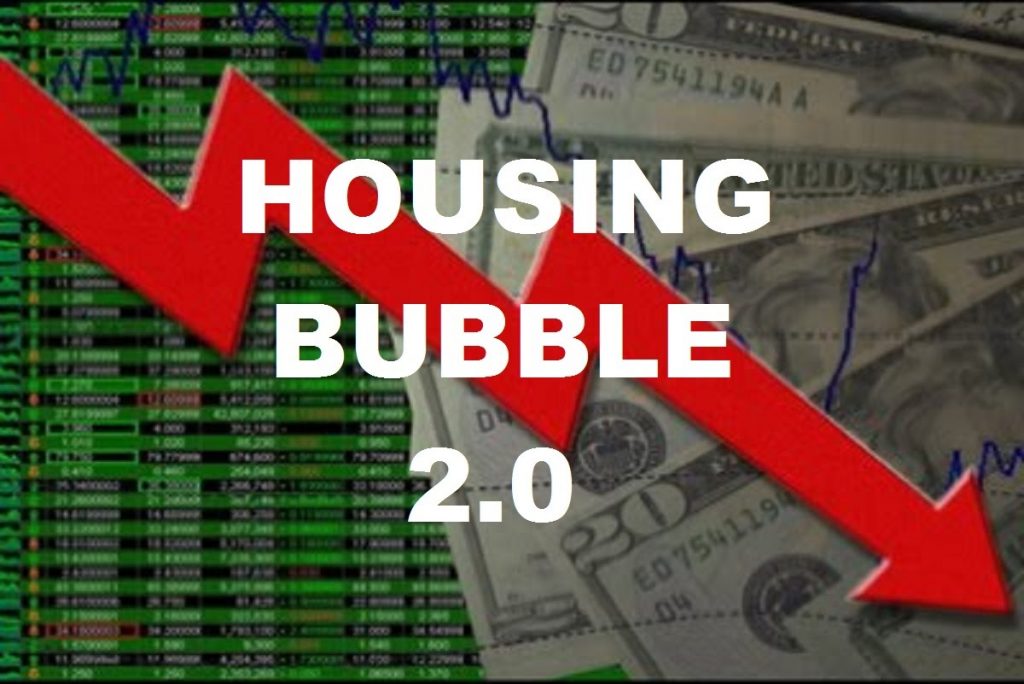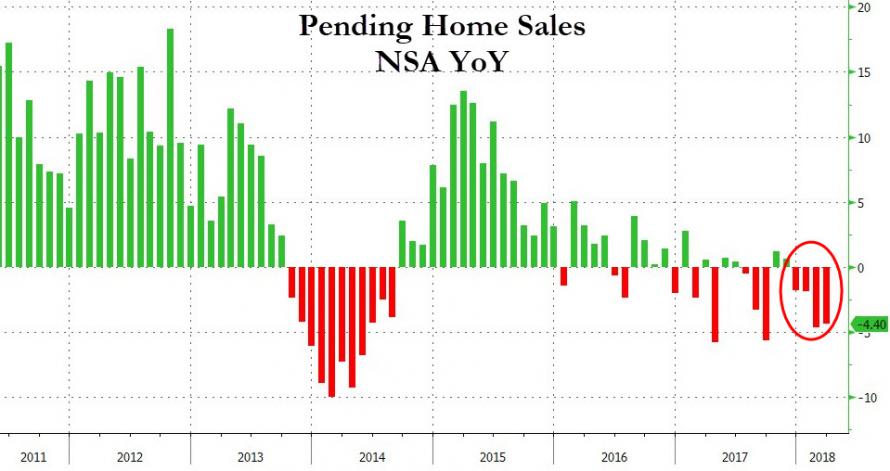- GOLD IRA
- Download Our 2024 Precious Metals IRA Investor’s Guide.
Click Here  Gold IRA
Gold IRA
 Investing
Investing
-
- CRYPTO IRA
- PRICES & STATS
- RETIREMENT PLANS
- BLOG
 Questions? Call (888) 820 1042
Questions? Call (888) 820 1042
U.S. Housing Market Façade Starts to Crack
Disclosure: Our content does not constitute financial advice. Speak to your financial advisor. We may earn money from companies reviewed. Learn more

Last week you saw the most recent housing numbers turn decisively sour. Existing and newly constructed homes for June both fell. New home construction plunged to 2017's low. Even the gains in rising home prices are slowing down after an overdone torrid pace. If this sounds like potentially bad news, it is. What led the Great Recession and eventually Global Financial Crisis was the housing market collapse in 2006-2007.
If you still needed a reason to diversity into IRA-approved gold, this is it. A significant decline in the prices of existing and new home construction could be the first domino that takes down the whole stock market house of cards with it. Gold makes sense in an IRA because it is not closely correlated to equities, bonds, or real estate. You need to start looking at Gold IRA asset allocation strategies before the situation deteriorates any further and drives up gold prices.
Mortgage Applications Decline As Mortgage Rates Rise
It is not only newly constructed and existing home sales together that have declined last month. Applications for mortgages with which to buy existing and new homes continue to decline steadily. It makes sense that rising mortgage rates are playing a part in this slowdown.
The mortgage rates are only rising in tandem with higher Federal Reserve-set U.S. interest rates. Once again, the erratic cycles of the U.S. economy largely come down to the machinations of the Fed. Is it any wonder a growing movement to abolish the Federal Reserve continues to slowly spread and gain support?
Single family homes' building also declined. It reached a new low dating back before June of 2017. All of these statistics go to show you that the long-touted housing market facade is at last starting to crack. This is also true in the most booing housing markets such as Denver. This hottest of metropolitan home markets saw steep declines in home sales for the year of 5.5 percent for June.
This chart shows the declining pending home sales across the U.S. national average:

The irony is that this happened even while the actual average prices touched a historical high point, per a RE/MAX report. It seems that even in the most on-fire housing markets in the U.S., the affordability ceiling exists, and it has been reached. CEO Adam Contos of RE/MAX explained the issues this way:
“Year over year prices have been climbing for more than two years now, which is great news for homeowners and sellers. The slower sales figures we're seeing are tired to inventory more than anything else.”
Despite his attempt to cover up for the declines, economists admit that the housing slowdown has resulted from prices that became too overheated. All housing markets have affordability limits. Unfortunately that limit has passed already.
As an example, consider the expensive Southern California market. In June, both the existing and new home sales numbers cratered versus June one year before per CoreLogic. The demand is still there, prices are still going up, yet more and more new and existing listings reveal reductions in price. Real estate agent David Goff of Burbank, California warned:
“The market is strong, but I'm seeing a noticeable difference in the number of buyers that are looking at my listings each week. We're still selling most every home, but now it is usually with just one or two offers over the 10 to 15 offers we were seeing earlier in the year. The anything goes list price strategy is no longer working. Buyers want to buy, but we're seeing fewer of them, and they are much more careful. Many properties are now not selling and/or coming down in price.”
This is a significant alarm bell that you should seriously consider.
Many Economic Casualties of the 10 Year Old Great Recession Still Remain
Part of the problem comes down to the fact that the economic recovery has never been broad-based. Too many people simply gave up looking for jobs. While the unemployment rate would seem to indicate that everyone who wants a job has one, the truth is that according to one way of looking at the Bureau of Labor Statistics 2017 report, someone in one in five American families/households is unemployed. These are not exactly confidence-inspiring figures.
Another key figure relates to homeowners. The percentage of Americans who own their own home is still significantly under the figure back in 2005. More than this, it is a whole percentage point beneath the average for fifty years. Millennial individuals are the biggest generation in the country, and they have not recovered financially from the Global Financial Crisis and Great Recession a decade ago. Chief Economist Sam Khater of Freddie Mac explained this with:
“This reflects the long-lasting scars from the Great Recession and the lopsided nature of this recovery. Despite years of continuous job growth and a slowly improving economy, it was only last year where we started to see an uptick in home-ownership.”
In other words, many individuals (in fact the largest generation) never recovered from the last financial collapse. This is bad news considering that we appear to be headed towards another one before long.
Housing Shortage Led to Bidding Wars and Overheated Home Prices
The unfortunate millennial generation can not seem to get a break. Only last year they finally began to recover enough financially to be able to try to climb onto the housing ladder. They quickly discovered that a crucial shortage of houses offered for sale were matched with an incredibly quick rising slate of house prices. It became normal to see bidding wars break out on properties across the country. This caused the interested young buyers to be often locked out of the housing market by soaring prices.
Realtor.com conducted a survey not long ago. They interviewed recent home closers in the two age groups of 18 to 34 and 35 to 54. The disturbing results were that fully 77 percent of all recent closers in the bracket of aged 18 to 34 had to adjust their home searches because of soaring costs for houses. Even 69 percent of those in the older (and usually financially more stable) bracket of from age 35 to 54 had to do the same.
Yet the all-important price limit is weighing heavily on sales of existing homes. These have declined for three straight months in part as a result of this overreached price limit. There are also simply not enough economical homes to go around for those who want to buy a house. Homes in the under $250,000 price bracket saw their sales drop sharply versus June in the prior year. Those in the price range of from $250,000 to $750,000 held flat more or less, per the National Association of Realtors.
Foreclosed Home Rentals Distorting the U.S. Real Estate Market
There are basically two reasons for why the dangerous shortage of homes' inventory exists at the lower range of the housing market. On the one hand, new home builders complain that they simply can not make money constructing homes that are lower-priced due to increasing materials and labor costs (also known as inflation).
The second reason has its roots in the Great Recession and sub-prime mortgage meltdown. Investors poured huge sums of money into buying up literally millions in low-end houses that entered foreclosure as a result of the housing crisis. They then transformed these abandoned properties into highly profitable single family home rentals. Today they maintain these properties to obtain the rent or only sell them on to still other investors who use them for the same purposes.
Gold Is Your Best Bet When Real Estate and Stock Markets Tank
Clearly all is not well in the real estate market. This is the very same sector responsible for the last crisis and financial collapse. This Great Recession was the worst recession since the Great Depression of the 1930‘s. This is why you simply can not afford to sacrifice including IRA-approved precious metals in your portfolio. Gold is your first, last, best, and only historically proven line of defense when financial crises strike.
You can safely store the precious metals you acquire for your Gold IRA in top offshore storage locations thanks to the IRS liberalizing their storage rules so that you no longer have to store the physical metals domestically as in the past. Today you are also able to buy gold in monthly installments. Get some while you still can.



 Silver
Silver Gold
Gold Platinum
Platinum Palladium
Palladium Bitcoin
Bitcoin Ethereum
Ethereum

 Gold: $2,387.15
Gold: $2,387.15
 Silver: $27.92
Silver: $27.92
 Platinum: $931.02
Platinum: $931.02
 Palladium: $903.43
Palladium: $903.43
 Bitcoin: $67,910.26
Bitcoin: $67,910.26
 Ethereum: $3,278.81
Ethereum: $3,278.81